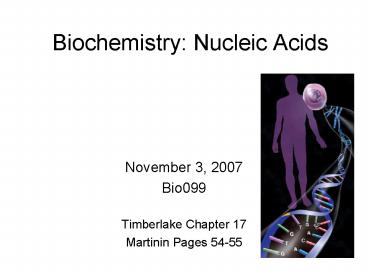Biochemistry: Nucleic Acids - PowerPoint PPT Presentation
1 / 38
Title:
Biochemistry: Nucleic Acids
Description:
The two DNA strands are unwound with the help of the enzyme HELICASE which ... A genetic code is used by the cell to translate the genetic material (mRNA) into ... – PowerPoint PPT presentation
Number of Views:2362
Avg rating:1.0/5.0
Title: Biochemistry: Nucleic Acids
1
Biochemistry Nucleic Acids
- November 3, 2007
- Bio099
- Timberlake Chapter 17
- Martinin Pages 54-55
2
Nucleic Acids The Big Picture
3
Two Types of Nucleic Acids
- Two Types
- DNA
- Deoxyribonucleic acid
4
Two Types of Nucleic Acids
- Two Types
- DNA
- Deoxyribonucleic acid
- RNA
- Ribonucleic acid
5
NucleotideThe monomer of nucleic acids
6
Molecular Components of the nucleotide
- Pentose sugar
7
Molecular Components of the nucleotide
- Pentose sugar
- Phosphate group
8
Molecular Components of the nucleotide
- Pentose sugar
- Phosphate group
- Nitrogenous bases
- purine pyrimidine
9
Nitrogenous Bases
BASES OF DNA
BASES OF RNA
10
Nucleoside
11
Primary Structure of Nucleic Acids
- Nucleotides are bound together to form nucleic
acids.
12
Primary Structure of Nucleic Acids
- Nucleotides are bound together to form nucleic
acids. - The sequence of bases is like an instruction
manual that can be read by the cell.
13
Secondary Structure of Nucleic Acids
- DNA
- The Double Helix
- The vertical blue strand represents the sugar
and phosphate group and the inner horizontal
bands represent the nitrogenous bases
14
Secondary Structure of Nucleic Acids
- DNA
- The Double Helix
- Complementary base pairs
15
Secondary Structure of Nucleic Acids
- DNA
- The Double Helix
- Complementary base pairs
- Helical
16
Secondary Structure of Nucleic Acids
- RNA
- Single stranded, but loopy in structure
17
DNA Replication
- Each time a cell divides, its entire genome must
be copied and passed on to the new cell.
18
DNA Replication
- 1 double helix replicates to give 2 new double
helixes
19
DNA Replication
- 1 double helix replicates to give 2 new double
helixes - The 2 new DNA molecules are made of 1 OLD and 1
NEW polynucleotide strands
20
The Steps of DNA Replication
- The two DNA strands are unwound with the help of
the enzyme HELICASE which facilitates the
breaking of the chemical bonds between the
molecules.
21
The Steps of DNA Replication
- DNA POLYMERASE helps to form bonds between the
nucleotides of the newly formed strand.
22
Protein SynthesisThe Big Picture
- DNA
- (instructions)
- RNA
- (copy of instructions)
- Protein
- (result of following instructions)
23
Protein Synthesis requires 3 types of RNA
- DNA
- RNA
- Protein
24
Three Types of RNA
- messenger RNA (mRNA)
- copy of a gene (DNA)
- leaves nucleus
- to carry genetic
- information to
- the ribosome for
- protein synthesis
25
Three Types of RNA
- ribosomal RNA (rRNA)
- part of the ribosome
26
Three Types of RNA
- transfer RNA (tRNA)
- transfers the amino acids
- to the ribosome for
- protein synthesis.
27
Steps of Protein Synthesis
- Transcription of the genetic material.
- making the mRNA.
28
Steps of Protein Synthesis
- The mRNA travels to the cytoplasm.
29
Steps of Protein Synthesis
- Translation of the mRNA
- The word translation is used because the language
is changing from nucleic acids to amino acids. - A genetic code is used by the cell to translate
the genetic material (mRNA) into a protein - 3 nucleotides of mRNA make a codon
- that translates to a specific amino
acid, - or a start or stop message during
- protein synthesis.
30
Steps of Protein Synthesis
- Translation of the mRNA is initiated with a start
codon.
31
Steps of Protein Synthesis
- Translation of the genetic material continues
and the polypeptide gets longer.
32
Steps of Protein Synthesis
- Termination occurs when a stop codon is reached.
33
Genetic Mutations
- Mutations are changes in the sequence of
nucleotides in DNA. - Mutations within a gene can alter the sequence of
amino acids in a protein causing changes, or lack
of protein function.
34
Types of Mutations
- Substitution
35
Types of Mutations
- Substitution
36
Types of Mutations
- Frameshift
37
Genetic Mutations and Disease
- A mutation in the gene that encodes the protein
leptin leads to marked obesity in rodents and
humans.
38
Genetic Diseases
- For more examples of genetic diseases caused by
mutations see Timberlake Table 17.5































